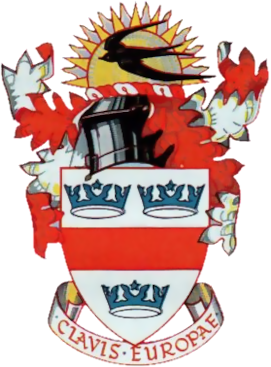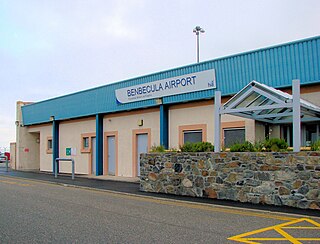
British European Airways (BEA), formally British European Airways Corporation, was a British airline which existed from 1946 until 1974.
Loganair is a Scottish regional airline headquartered at Glasgow Airport in Paisley, Renfrewshire, Scotland. The airline primarily operates domestic flights within the United Kingdom. It is the largest regional airline in Scotland by passenger numbers and fleet size.

British Airways Ltd was a British airline company operating in Europe in the period 1935–1939. It was formed in 1935 by the merger of Spartan Air Lines Ltd, United Airways Ltd, and Hillman's Airways. Its corporate emblem was a winged lion.

Islay Airport is located 4.5 nautical miles north-northwest of Port Ellen on the island of Islay in Argyll and Bute, off the west coast of Scotland. It is a small rural airport owned and maintained by Highlands and Islands Airports Limited. Today the airport is used for scheduled services to the Scottish mainland, and for air ambulances.

Benbecula Airport is located on the island of Benbecula in the Outer Hebrides, off the West Coast of Scotland. It is a small rural airport owned and maintained by Highlands and Islands Airports Limited.

Royal Air Force East Fortune, or more simply RAF East Fortune, is a former Royal Air Force station located just south of the village of East Fortune. It is a short distance east of Edinburgh, in Scotland. RAFEast Fortune was used as a fighter station during the First World War and later used by a night fighter operational training unit during the Second World War. The motto of the station is "Fortune Favours the Bold".
Antonio-Agostinho-Neto International Airport is an airport serving Pointe-Noire, a coastal city in the Republic of Congo. The runway is surrounded by the densely populated city, and is 3 kilometres (1.9 mi) inland from the Atlantic shore.

Hall Caine Airport, also referred to as Close Lake Airfield, was an airfield on the Isle of Man located near the town of Ramsey. It was named after the author Sir Thomas Henry Hall Caine CH, KBE by his sons Gordon Hall Caine and Derwent Hall Caine, who initiated the project, and was the first airport in the British Isles to be named after a person.

Wake Island Airfield is a military air base located on Wake Island, which is known for the Battle of Wake Island during World War II. It is owned by the U.S. Air Force and operated by the 611th Air Support Group. The runway can be used for emergency landings by commercial jetliners flying transpacific routes and has been used in the past by airlines operating jet, turboprop, and prop aircraft on scheduled flights.

Cambrian Airways was an airline based in the United Kingdom which ran operations from Cardiff Airport and Liverpool John Lennon Airport between 1935 and 1974. It was incorporated into British Airways when BOAC, BEA, Cambrian and Northeast merged on 1 April 1974.
Compagnie des messageries aériennes was a pioneering French airline which was in operation from 1919–23, when it was merged with Grands Express Aériens to form Air Union.
United Airways Ltd was a British airline operating in 1935, ending as part of British Airways Ltd.
Allied Airways was a UK airline based at Aberdeen, Scotland. Formed in 1934 as Aberdeen Airways it was taken over by British European Airways in 1947.

Bekesbourne Aerodrome was an airport located at the southeast edge of the village of Bekesbourne, southeast of Canterbury, Kent. It operated from 1916 until 1940, and had both military and civil roles.
Highland Airways Limited was established in Inverness, Scotland, by Ted Fresson in 1933 to provide passenger and freight air services between the Scottish mainland and the Northern Isles of Orkney and Shetland, and between their islands. The airline was taken over by Scottish Airways, absorbed by British European Airways in 1947.
Scottish Airways was an airline serving most of Scotland, especially the Highlands and Islands. It was active from 1937 until 1947, when it was merged into British European Airways.
Midland & Scottish Air Ferries was Scotland's first airline, operating from 1933 to 1934. It is particularly noted for pioneering flights to the Inner Hebrides

Lancashire Aircraft Corporation was a major British charter airline after World War II. Its founding father was Eric Rylands. It played an important role in the Berlin Airlift. It also flew scheduled routes and was important in the development of Coach-air services, leading to the founding of Skyways Coach Air and the start of the Inclusive Tour (IT) industry. Its major subsidiary, Samlesbury Engineering, supported its operations and converted many military aircraft for commercial use, also founding Lancashire Aircraft Company.
North Eastern Airways (NEA) was a British airline which operated from 1935 until the outbreak of World War II in 1939. Based initially in Newcastle upon Tyne, it operated routes from Scotland to London in competition with the railways, retaining its independence to the end.
Cramlington Aerodrome was a military airfield established in Northumberland during the First World War. It became a civil airfield serving the Tyneside area of north-east England and operated until 1935, when it was replaced by Woolsington Airport, now known as Newcastle International Airport.













